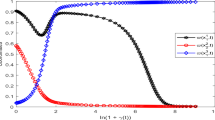Abstract
A firm needs to tailor its pricing strategy to the particular competitive setting it faces. We show how a firm can select a pricing strategy that yields higher expected profit than other simple pricing strategies for the competitive conditions encountered. We show that no one strategy yields the highest expected profit for all competitive settings. In particular, we find that a more aggressive pricing strategy is needed for those markets that are either very cooperative or very competitive, while a more cooperative pricing strategy is preferred for markets which have a moderate degree of competition. We also find that a more aggressive pricing strategy is needed as the number of competitors increases. Our results suggest how to choose the pricing strategy that yields the highest expected profit given the likely behavior of a firm's competitors.
Similar content being viewed by others
References
Axelrod, Robert. (1980a). “Effective Choice in the Prisoner's Dilemma,”Journal of Conflict Resolution 24 (1), 3–25.
Axelrod, Robert. (1980b). “More Effective Choice in the Prisoner's Dilemma,”Journal of Conflict Resolution 24 (3), 379–403.
Axelrod, Robert. (1984).The Evolution of Cooperation, New York, Basic Books.
Blattberg, Robert C., and Scott A. Neslin. (1990).Sales Promotion: Concepts, Methods and Strategies. Englewood Cliffs, NJ: Prentice Hall.
Carpenter, Gregory S., Lee G. Cooper, Dominique M. Hanssens, and David F. Midgley. (1988). “Modeling Asymmetric Competition,”Marketing Science 7 (4), 393–412.
Davis, K. Roscoe, and L. F. Simmons. (1976). “Exploring Market Pricing Strategies Using Dynamic Programming,”Decision Sciences 7 (2), 181–193.
Eliashberg, Jehoshua, and R. Chatterjee. (1985). “Analytical Models of Competition with Implications for Marketing: Issues, Findings, and Outlook,”Journal of Marketing Research 22 (August), 237–261.
Fader, Peter S. (1987). “Effective Strategies for Oligopolistic Games,” unpublished doctoral dissertation, Massachusetts Institute of Technology.
Fader, Peter S., and John R. Hauser. (1988). “Implicit Coalitions in a Generalized Prisoner's Dilemma,”Journal of Conflict Resolution 32 (3), 553–582.
Friedman, John W. (1977),Oligopoly and the Theory of Games. Amsterdam: North-Holland.
Friedman, John W. (1986).Game Theory with Applications to Economics. New York: Oxford University Press.
Griffith, David E. (1988). “Strategies for Profit in Competitive Markets,” unpublished doctoral dissertation, University of Texas at Austin.
Henderson, Bruce D. (1983). “The Anatomy of Competition,”Journal of Marketing 47 (Spring). 7–11.
Johnston, J. (1984).Econometric Methods. New York: McGraw-Hill.
Komorita, S. S., James Sweeny, and David A. Kravitz. (1980). “Cooperative Choice in the N-Person Dilemma Situation,”Journal of Personality and Social Psychology 38 (3), 504–516.
Kreps, David, and Robert Wilson. (1982), “Reputation and Imperfect Information,”Journal of Economic Theory 27, 253–279.
Lambert, Jean J., Phillipe Naert, and Alain Bultez. (1975). “Optimal Marketing Behavior in Oligopoly,”European Economic Review 6 (1), 105–128.
Mesak, Hani I., and Richard C. Clelland. (1979). “A Competitive Pricing Model,”Management Science 25 (11), 63–74.
Nash, John F. (1951). “Non-Cooperative Games,”Annals of Mathematics 54, 286–295.
Pevsner, Donald L. (1990). “Those Awful Shuttle Fares,”The New York Times, Sunday, January 21, F13.
Rao, Ambar, and Melvin F. Shakun. (1972). A Quasi-Game Theory Approach to Pricing,”Management Science 18 (15), 110–123.
Rao, Ram C. (1987). “Pricing and Promotions in Asymmetric Duopolies,” Working Paper, University of Texas at Dallas.
Rappoport, Anatol, and Albert Chammah. (1965).Prisoner's Dilemma. Ann Arbor: The University of Michigan Press.
Shugan, Steven M., and Abel P. Jeuland. (1988). “Competitive Pricing Behavior in Distribution Systems.” In Timothy Devinney (ed.),Issues in Pricing: Theory and Research. Lexington, MA: Lexington Books, 289–312.
Simon, Hermann. (1979). “Dynamics of Price Elasticity and Brand Life Cycle: An Empirical Study,”Journal of Marketing Research 16 (November), 439–452.
Swasy, Alicia. (1990). “Weyerhaeuser Unveils Hybrid Diaper Brand,”The Wall Street Journal, January 26, B1 and B4.
Tesler, Lester G. (1962). “The Demand for Brand Goods as Estimated from Consumer Panel Data,”Review of Economics and Statistics 44 (August), 300–324.
von Neuman, John, and Oscar Morgenstern. (1953).Theory of Games and Economic Behavior. Princeton: Princeton University Press.
Weitz, Barton. (1985). “Introduction to Special Issue on Competition in Marketing,”Journal of Marketing Research 22 (August), 180–185.
Wilson, John G. (1986). “Subjective Probability and the Prisoners' Dilemma,”Management Science 32 (1), 45–55.
Wind, Yoram, and Thomas S. Robertson. (1983). “Marketing Strategy: New Directions for Theory and Research,”Journal of Marketing 47 (Spring), 12–25.
Author information
Authors and Affiliations
Additional information
The authors thank Terry Elrod and Robert Lusch for their comments on earlier versions of this paper.
Rights and permissions
About this article
Cite this article
Griffith, D.E., Rust, R.T. Effectiveness of some simple pricing strategies under varying expectations of competitor behavior. Marketing Letters 4, 113–126 (1993). https://doi.org/10.1007/BF00994070
Issue Date:
DOI: https://doi.org/10.1007/BF00994070




